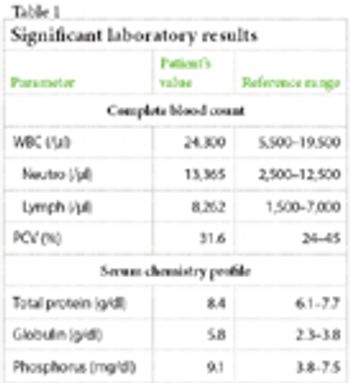
Help veterinary technicians master their jobs with this sample five-week technician expectation log.

Help veterinary technicians master their jobs with this sample five-week technician expectation log.

This potentially fatal zoonotic disease is becoming more prevalent in the U.S., making it even more crucial to look out for clinical signs.

Consider this sample veterinary team newsletter, then create your own to boost team spirit.

Researchers at Kansas State University have created a quicker, more effective way to identify the known strains of this deadly virus in dogs.

Methicillin-resistant organisms are being recovered more and more frequently from canine skin cultures, and concerns about transmission are increasing.

Five investigators to be given $15,000 to carry out studies in 2014.

While both work in the interest of veterinary medicine, the two veterinarian-congressmen couldn't be more different politically.

While both work in the interest of veterinary medicine, the two veterinarian-congressmen couldn't be more different politically.

While both work in the interest of veterinary medicine, the two veterinarian-congressmen couldn't be more different politically.

Steele credited with introducing the principles of One Health to the world.

A recent evaluation by a National Research Council committee sheds light on the National Wild Horses and Burros Program.

A recent evaluation by a National Research Council committee sheds light on the National Wild Horses and Burros Program.

Organizers hope conference will encourage translational medical programs

A recent study examined whether young puppies that attend socialization classes are really at an increased risk for this deadly viral disease.

Dr. Lindsay Ruland's clients, staff--even her children--experience symptoms she says seem related to canine condition reported in Ohio and Michigan.

Investigators continue to seek explanation for canine cases in Ohio, Michigan.

Veterinary, human medical researchers identify FIV peptide that kills HIV.

Zoetis affirms its commitment to finding a solution to help control the recent outbreak of porcine epidemic diarrhea virus (PEDv).

Events will be held worldwide and across the United States.

The University of Minnesota Veterinary Diagnostic Laboratory began accepting test samples mere months after the PEDV outbreak began.

A case study of a neutered male domestic shorthaired cat who presented for evaluation of hyporexia and labored breathing of three weeks' duration.

Drs. Cook and Nelson offer an overview of diagnostics, treatment, prognosis and prevention for feline infectious peritonitis.

Need-to-know information about minimizing the risk of disease transmission and documenting infection incidence in a healthcare setting.

Mortality rate in suckling pigs as high as 100 percent creates potential impact on pork supply.

Skin graft techniques used in human medicine utilized in veterinary treatment of Northstar's wounds.